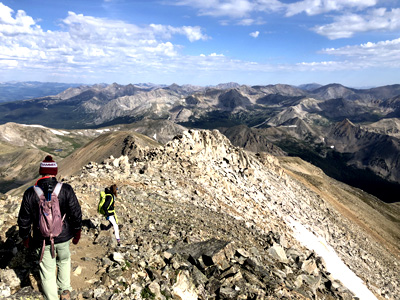As the summer winds down, many Coloradans and visitors are planning their final Fourteener summits before the winter weather hits. Colorado is home to 58 Fourteeners – mountain peaks with an elevation 14,000+ feet above sea level – that are climbed by hundreds of thousands of hikers each year. The unique and exhilarating experience of climbing a Fourteener is undoubtedly priceless, but economists are still interested in estimating the economic benefits (and costs) of Colorado’s Fourteeners.

Outdoor recreation is a big business in Colorado. According to the Colorado Outdoor Recreation Industry Office, outdoor recreation added $9.6 billion to Colorado’s GDP and contributed 120,000 direct jobs in 2020. The 2017 Economic Contributions of Outdoor Recreation in Colorado report estimates that 90% of Coloradans participated in outdoor recreation activities during the study year, with trail activities like hiking being the most popular of the 30 outdoor activities studied. These outdoor enthusiasts spent nearly $37 billion on activities and equipment in 2017.
The importance of outdoor recreation on Colorado’s state and local economies is clear, but how do we determine the value of Fourteeners to the economy and to individual hikers? Colorado State University Extension economists set out to answer this question in a series of three reports:
- The economics of Colorado Fourteeners: research summary (2007) is an accessible explanation of the methods economists use to estimate the value of natural resources. The authors also cover the ecological cost of increased Fourteener use over the past few decades, leading to widened trails and erosion in fragile alpine environments. These heavily-used trails, along with their associated campgrounds, parking lots, and roads, all require money for maintenance.
- Colorado Fourteeners: estimating a price on the “priceless”: a primer on when and how to apply economics to the environment (2008) explains why economists want to assign a monetary value to a “priceless” outdoor experience. For an important natural resource like Fourteeners, it’s helpful for land management agencies and elected officials to understand the value of Fourteeners in monetary terms. This can help adequately allocate budgets to maintain Fourteener access for future use. This report also outlines two ways that economists can measure the value of Fourteeners: “contributions to local economy” and “value-added.”
- In When nothing else will do: Colorado Fourteeners and the effect of limited substitutes on recreation economic benefits (2008), the authors switch their focus to determine how valuable Fourteeners are to those who climb them. They found that visitors place a high value on the “uniqueness” of the Fourteener experience, especially if a visitor is focused on climbing a particular mountain or is intent on achieving a personal goal. For example, a visitor may place a higher value on climbing Mt. Elbert, the highest mountain peak in Colorado, than other Fourteeners.
For more information about the economic impact of outdoor recreation in Colorado, the Outdoor Recreation Industry Office’s “Resources” webpage contains links to several economic impact reports. This office also provides information to help communities build outdoor recreation economies, including a toolkit for rural communities and access to funding opportunities.
- Colorado’s Governors: Ralph L. Carr - July 11, 2025
- Celebrating Colorado’s immigrant heritage - June 27, 2025
- Colorado’s Scenic and Historic Byways: Guanella Pass - June 6, 2025